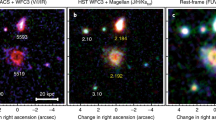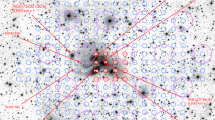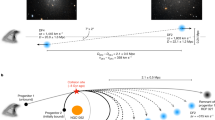Abstract
The unusual morphology of the Andromeda galaxy (Messier 31, the closest spiral galaxy to the Milky Way) has long been an enigma. Although regarded for decades as showing little evidence of a violent history, M31 has a well-known1,2,3,4,5,6,7 outer ring of star formation at a radius of ten kiloparsecs whose centre is offset from the galaxy nucleus. In addition, the outer galaxy disk is warped, as seen at both optical8 and radio9 wavelengths. The halo contains numerous loops and ripples. Here we report the presence of a second, inner dust ring with projected dimensions of 1.5 × 1 kiloparsecs and offset by about half a kiloparsec from the centre of the galaxy (based upon an analysis of previously-obtained data10). The two rings appear to be density waves propagating in the disk. Numerical simulations indicate that both rings result from a companion galaxy plunging through the centre of the disk of M31. The most likely interloper is M32. Head-on collisions between galaxies are rare, but it appears nonetheless that one took place 210 million years ago in our Local Group of galaxies.
This is a preview of subscription content, access via your institution
Access options
Subscribe to this journal
Receive 51 print issues and online access
$199.00 per year
only $3.90 per issue
Buy this article
- Purchase on Springer Link
- Instant access to full article PDF
Prices may be subject to local taxes which are calculated during checkout


Similar content being viewed by others
References
Brinks, E. & Shane, W. W. A high resolution hydrogen line survey of Messier 31. I. Observations and data reduction. Astron. Astrophys. Suppl. 55, 179–251 (1984)
Dame, T. M., Koper, E., Israel, F. P. & Thaddeus, P. A complete CO survey of M31. I. Distribution and kinematics. Astrophys. J. 418, 730–742 (1993)
Nieten, Ch. et al. Molecular gas in the Andromeda galaxy. Astron. Astrophys. 453, 459–475 (2006)
Haas, M. et al. Cold dust in the Andromeda Galaxy mapped by ISO. Astron. Astrophys. 338, L33–L36 (1998)
Gordon, K. D. et al. Spitzer MIPS Infrared Imaging of M31: Further evidence for a spiral-ring composite structure. Astrophys. J. Lett. 638, L87–L92 (2006)
Beck, R., Berkhuijsen, E. M. & Hoernes, P. A deep λ20 cm radio continuum survey of M 31. Astron. Astrophys. 329–336 (1998)
Pellet, A. et al. A survey of H II regions in M31. Astron. Astrophys. 439–461 (1978)
Ibata, R. et al. A giant stream of metal-rich stars in the halo of the galaxy M31. Nature 412, 49–51 (2001)
Braun, R. The distribution and kinematics of neutral gas in M31. Astrophys. J. 372, 54–66 (1991)
Barmby, P. et al. Dusty waves on a starry sea: the mid-infrared view of M31. Astrophys. J. Lett. (in the press); preprint at 〈http://arXiv.org/astro-ph/0608593〉 (2006)
Fazio, G. G. et al. The Infrared Array Camera (IRAC) for the Spitzer Space Telescope. Astrophys. J. Suppl. 154, 10–17 (2004)
Stanek, K. Z. & Garnavich, P. M. Distance to M31 with the Hubble Space Telescope and HIPPARCOS red clump stars. Astrophys. J. Lett. 503, L131–L134 (1998)
Baade, W. Evolution of Stars and Galaxies 56–68 (Harvard Univ. Press, Cambridge, 1963)
Jacoby, G. H., Ford, H. & Ciardullo, R. Ionized gas in the center of M31. Astrophys. J. 290, 136–139 (1985)
Willaime, M-C., Lequeux, J., Melchior, A-L. & Hanus, M. in The Promise of the Herschel Space Observatory (eds Pilbratt, G. L. et al.) 519–521 (ESA-SP-460, European Space Agency, Noordwijk, 2001)
Ciardullo, R. et al. The morphology of the ionized gas in M31’s bulge. Astron. J. 95, 438–444 (1988)
Appleton, P. N. & Struck-Marcell, C. Collisional ring galaxies. Fundamentals Cosmic Phys. 16, 111–220 (1996)
Buta, R. The catalog of southern ringed galaxies. Astrophys. J. Suppl. 96, 39–116 (1995)
Block, D. L. et al. The gravitational torque of bars in optically unbarred and barred galaxies. Astron. Astrophys. 375, 761–769 (2001)
Beaton, R. L. et al. Unveiling the boxy bulge and bar of the Andromeda Spiral Galaxy. Astrophys. J. Lett. (submitted).
Bournaud, F. & Combes, F. Formation of polar ring galaxies. Astron. Astrophys. 401, 817–833 (2003)
Welch, G. A. & Sage, L. J. The Interstellar Medium of M32. Astrophys. J. 557, 671–680 (2001)
Gerber, R. A., Lamb, S. A. & Balsara, D. S. A stellar and gas dynamical numerical model of ring galaxies. Mon. Not. R. Astron. Soc. 278, 345–366 (1996)
Unwin, S. C. Neutral hydrogen in the Andromeda Nebula—III. The velocity field. Mon. Not. R. Astron. Soc. 205, 773–786 (1983)
Shu, F. H., Milione, V. & Roberts, W. W. Nonlinear gaseous density waves and galactic shocks. Astrophys. J. 183, 819–842 (1973)
Struck-Marcell, C. & Higdon, J. L. Hydrodynamic models of the Cartwheel ring galaxy. Astrophys. J. 411, 108–124 (1993)
Horellou, C. & Combes, F. A model for the Cartwheel ring galaxy. Astrophys. Space Sci. 276, 1141–1149 (2001)
Lavery, R. J., Remijan, A., Charmandaris, V., Hayes, R. D. & Ring, A. A. Probing the evolution of the galaxy interaction/merger rate using collisional ring galaxies. Astrophys. J. 612, 679–689 (2004)
Elmegreen, D. M., Elmegreen, B. G., Rubin, D. S. & Schaffer, M. A. Galaxy morphologies in the Hubble Ultra Deep Field: dominance of linear structures at the detection limit. Astrophys. J. 631, 85–100 (2005)
Mateo, M. Dwarf galaxies of the Local Group. Annu. Rev. Astron. Astrophys. 36, 435–506 (1998)
Acknowledgements
This work is based on observations made with the Spitzer Space Telescope, which is operated by the Jet Propulsion Laboratory, California Institute of Technology under a contract with NASA. Funding for this work was provided by the Anglo American Chairman’s Fund as well as by NASA through an award issued by JPL/Caltech. Author Contributions P.B., G.G.F., M.L.N.A., M.A.P. and S.P.W. provided the IRAC data of M31 on which the analyses are based. D.L.B. initiated the collaboration between the USA, France and WITS, South Africa and identified Baade dust spirals in emission in the central region of M31. F.C. discovered the central ring between the inner Baade arms and believed it to be induced by a head-on collision. F.B. performed the numerical simulations which fully corroborated this interpretation and also generated Figs 1 and 2. R.G. cleaned the IRAC images of foreground stars and conducted Fourier spectral analysis of the Baade arms. F.C. and F.B. provided crucial drafts of this Letter. The final revised versions were prepared by D.L.B., S.P.W, R.G. and M.L.N.A.
Author information
Authors and Affiliations
Corresponding author
Ethics declarations
Competing interests
Reprints and permissions information is available at www.nature.com/reprints. The authors declare no competing financial interests.
Supplementary information
Supplementary Notes
This file contains the Supplementary Methods and Supplementary Figures 1–3. (PDF 120 kb)
Rights and permissions
About this article
Cite this article
Block, D., Bournaud, F., Combes, F. et al. An almost head-on collision as the origin of two off-centre rings in the Andromeda galaxy. Nature 443, 832–834 (2006). https://doi.org/10.1038/nature05184
Received:
Accepted:
Issue Date:
DOI: https://doi.org/10.1038/nature05184
This article is cited by
-
The Andromeda galaxy’s most important merger about 2 billion years ago as M32’s likely progenitor
Nature Astronomy (2018)
-
Galactic collision gave Andromeda its arms
Nature (2014)
-
First results from the POMME survey of M31
Astrophysics and Space Science (2012)
Comments
By submitting a comment you agree to abide by our Terms and Community Guidelines. If you find something abusive or that does not comply with our terms or guidelines please flag it as inappropriate.



